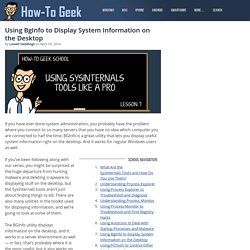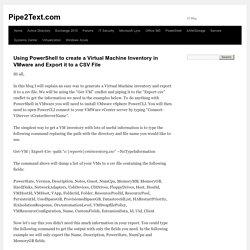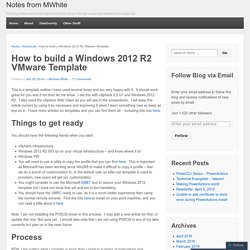

André
SysInternals Pro: Using BgInfo to Display System Information on the Desktop. If you have ever done system administration, you probably have the problem where you connect to so many servers that you have no idea which computer you are connected to half the time.

BGInfo is a great utility that lets you display useful system information right on the desktop. And it works for regular Windows users as well. If you’ve been following along with our series, you might be surprised at the huge departure from hunting malware and deleting crapware to displaying stuff on the desktop, but the SysInternals tools aren’t just about finding things to kill. There are also many utilities in the toolkit used for displaying information, and we’re going to look at some of them. The BGInfo utility displays information on the desktop, and it works in a server environment as well — in fact, that’s probably where it is the most useful, but it also works on anybody’s computer, so you can test things out on your local machine before running the configuration on the server.
Email. IT Security. Backups. Exchange. Using PowerShell to create a Virtual Machine Inventory in VMware and Export it to a CSV File. Hi all, In this blog I will explain an easy way to generate a Virtual Machine inventory and export it to a csv file.

We will be using the “Get-VM” cmdlet and piping it to the “Export-csv” cmdlet to get the information we need in the examples below. To do anything with PowerShell in VMware you will need to install VMware vSphere PowerCLI. You will then need to open PowerCLI connect to your VMWare vCenter server by typing “Connect-VIServer vCenterServerName”. The simplest way to get a VM inventory with lots of useful information is to type the following command replacing the path with the directory and file name you would like to use. PsTools. How to Install PowerShell on Windows Server 2003 and Enable Remote PowerShell Management–All Servers Should Have This Done - ITProGuru Blog by Systems Management Expert Dan Stolts.
TechNet Wiki.
Download Remote Server Administration Tools for Windows 10 from Official Microsoft Download Center. Remote Server Administration Tools (RSAT) for Windows operating systems. Remote Server Administration Tools (RSAT) enables IT administrators to remotely manage roles and features in Windows Server 2012 R2, Windows Server 2012, Windows Server 2008, and Windows Server 2008 R2 from a computer that is running Windows 10, Windows 8.1, Windows 8, Windows 7, or Windows Vista.

You cannot install RSAT on computers that are running Home or Standard editions of Windows. You can install RSAT only on Professional or Enterprise editions of the Windows client operating system. Unless the download page specifically states that RSAT applies to a beta, preview, or other prerelease version of Windows, you must be running a full (RTM) release of the Windows operating system to install and use RSAT. Although some users have found ways of manually cracking or hacking the RSAT MSU to install RSAT on unsupported releases or editions of Windows, this is a violation of the Windows end-user license agreement. Add a user or group as a DHCP administrator at a domain controller: Dynamic Host Configuration Protocol (DHCP) Updated: January 21, 2005 Applies To: Windows Server 2003, Windows Server 2003 R2, Windows Server 2003 with SP1, Windows Server 2003 with SP2 To add a user or group as a DHCP administrator at a domain controller Open Active Directory Users and Computers if the DHCP server is installed at a domain controller.

In the console tree, click Users.Where? How to build a Windows 2012 R2 VMware Template. This is a template outline I have used several times and am very happy with it.

It should work great for you and if not then let me know. I did this with vSphere 5.5 U1 and Windows 2012 R2. I also used the vSphere Web Client as you will see in the screenshots. Setting the Desktop Wallpaper Background with Group Policy - DeployHappiness. Setting the Desktop Wallpaper Background with Group Policy is a fairly common request from administration or management.

Unfortunately, the actual setup is not as straightforward as you would think. As with any Microsoft product, there are a myriad of ways to configure this and every way has a unique set of features (and drawbacks). In this guide, we will cover two ways of setting the desktop wallpaper background with Group Policy plus a few tricks that you’ll need to know first. Question Time Before configuring even a single option – ask yourself these two questions first: Windows - Enforcing lock screen after idle time via GPO. SistemasWin.com: File Server: Add Quotas in Windows Server 2012 R2 with Powershell. Enabling debug logging for the Netlogon service. Important This section, method, or task contains steps that tell you how to modify the registry.

However, serious problems might occur if you modify the registry incorrectly. Therefore, make sure that you follow these steps carefully. For added protection, back up the registry before you modify it. Then, you can restore the registry if a problem occurs. For more information about how to back up and restore the registry, click the following article number to view the article in the Microsoft Knowledge Base: Cannot rename this connection - NIC Server 2008-R2. Hi, In addition, you can check the KB below: Please check the registry key below:

SysInternals Pro: Using BgInfo to Display System Information on the Desktop. Enable TLS 1.2 Ciphers in IIS 7.5, Server 2008 R2, Windows 7. Some industries, like Government, require the use of certain cryptography algorithms.

One of the great features of Windows Server 2008 R2 and Windows 7 is the support for TLS 1.2 ciphers. TLS 1.2 ciphers support AES-256 encryption with SHA-256 hashes. Unfortunately, Microsoft did not enable these protocols out of the box. Forward secrecy. History[edit] Forward secrecy was originally introduced by Whitfield Diffie, Paul van Oorschot, and Michael James Wiener.

It used to describe a property of the Station-to-Station protocol (STS), where the long-term secrets are private keys.[2] Forward secrecy has also been used to describe the analogous property of password-authenticated key agreement protocols where the long-term secret is a (shared) password.[3] Annex D.5.1 of IEEE 1363-2000 discusses the related one-party and two-party forward secrecy properties of various standard key agreement schemes. Perfect forward secrecy[edit] Strong SSL Security on Apache2. 25-03-2015 | Remy van Elst This tutorial shows you how to set up strong SSL security on the Apache2 webserver. We do this by disabling SSL Compression to mitigate the CRIME attack, disable SSLv3 and below because of vulnerabilities in the protocol and we will set up a ciphersuite that enables Forward Secrecy when possible.
We also set up HSTS and HPKP. Secure Server: TLS v1.1 and v1.2 Support - Speaking of Security. The recent “BEAST” and “Lucky Thirteen” attacks have made clear that it is time to use the newer versions of TLS: v1.1 and v1.2. TLS v1.2 also adds the new, safer GCM cipher suites and changes the MD5/SHA-1 handshake hash for a simple SHA-2 hash. The following table shows a list of common browsers and the version they first started supporting TLS v1.1 and v1.2: 1 Support is disabled by default.2 Different engine, support now on by default. The browsers listed above account for over 98.5% of the market as reported by w3school in September. Note that these statistics are for all versions and not just those that support TLS v1.1 and v1.2. Not all versions of each browser have support enabled by default. How to disable SSL 2.0 and force SSL 3.0 and TLS 1.0 in IIS. I lot of places want to disable weaker encryption levels and require more secure encryption levels. There isn’t a lot of clear procedures out there that explain how this is done.
So for the greater good, I’m posting it here. Follow these steps to make the change manually: Back up your registry (outside link) Disable SSL 2.0: Browse to the “HKEY_LOCAL_MACHINE\SYSTEM\CurrentControlSet\Control\SecurityProviders\SCHANNEL\Protocols\SSL 2.0″ key. There is probably a key there called “Client”. SSL Server Test (Powered by Qualys SSL Labs) Hardening Your Web Server’s SSL Ciphers — Hynek Schlawack. Support.microsoft. How To Install an SSL Certificate For Apache Servers. Testing Network Services with netcat. Setting, Changing And Resetting MySQL Root Passwords.
Firelit Design: Fixing InnoDB error "the age of the last checkpoint is..." CommonMisconfigurations - Httpd Wiki. This page will describe common misconfigurations as seen in #apache as well as describe why these are wrong. Name Based Virtual Host Not matching the value of NameVirtualHost with a corresponding <VirtualHost> block. TutorialCachingStory - memcached - This is a story of Caching - Memcached. Ed note: this is an overview of basic memcached use case, and how memcached clients work Two plucky adventurers, Programmer and Sysadmin, set out on a journey. Windows/Temp directory is full of Php Session's files that block the server. Nginx vs Apache - Anturis Blog. NodeSchool.
Functional Javascript Learn fundamental functional programming features of JavaScript in vanilla ES5.
Centos - Why does MySQL Slow Queries Log not exist? How To Repair Corrupted MySQL Tables Using myisamchk. By Ramesh Natarajan on September 1, 2008 MyISAM is the default storage engine for MySQL database. How to Install ClamAV and Configure Daily Scanning on CentOS - Shine Servers. ClamAV is an open source (GPL) antivirus engine designed for detecting Trojans, viruses, malware and other malicious threats on Linux. IIS. Apache. XEN. VMware. NTFS Misreports Free Space? - Ntdebugging Blog. Pareto principle. PsTools. How to install, configure and manage vsftpd on Linux CentOS. Performance indicator. The Foreman.